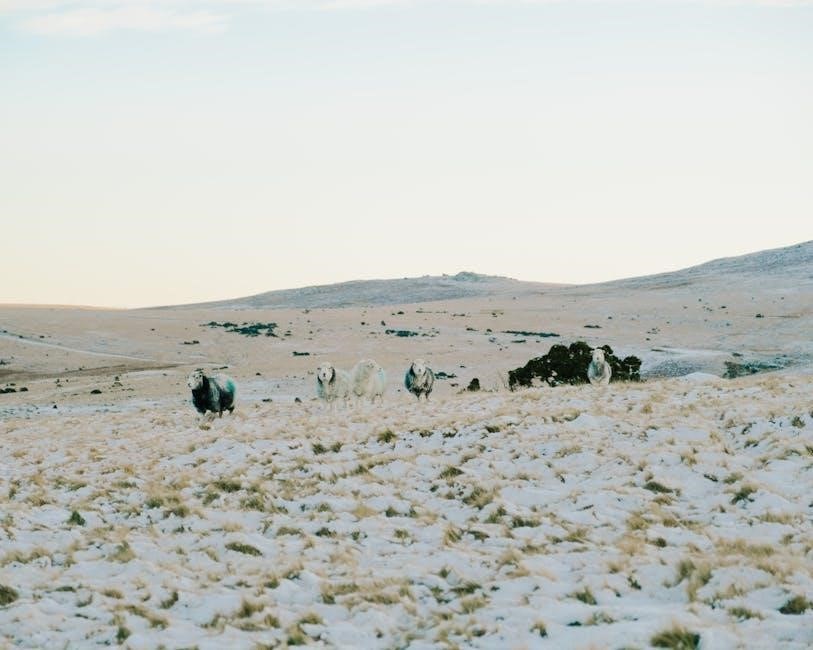hills like white elephants pdf
“Hills Like White Elephants”: An Analysis
Ernest Hemingway’s “Hills Like White Elephants” is a complex short story exploring a couple’s tense discussion. The narrative masterfully employs dialogue and symbolism to subtly reveal their conflict and unhappiness. The story revolves around a significant, unspoken decision concerning their future.
Plot Summary of “Hills Like White Elephants”
The story unfolds at a train station in Spain, where an American man and a young woman, Jig, await a train to Madrid. While waiting, they sit at a table outside the station, ordering drinks and engaging in what seems like a casual conversation. However, beneath the surface, a weighty issue looms: Jig’s pregnancy and the possibility of an abortion. The American attempts to persuade Jig to undergo the procedure, framing it as a simple operation that will restore their relationship to its former state.
Jig expresses her uncertainty and doubts, questioning whether their relationship will truly return to normal afterward. The couple’s dialogue is filled with veiled language, unspoken resentments, and a struggle for control. The tension escalates as they discuss the operation, revealing their incompatibility and the strain on their relationship. Ultimately, Jig asks the man to stop talking, signaling her weariness with the conversation and her need to make her own decision. The story concludes without a resolution, leaving the reader to ponder the fate of the couple and the unborn child.
Character Analysis
Hemingway’s “Hills Like White Elephants” features three characters, each contributing to the story’s central conflict. The American is portrayed as a manipulative figure, attempting to persuade Jig to have an abortion. He downplays the procedure’s significance, emphasizing its simplicity and promising a return to their former happiness. Jig, the young woman, is presented as uncertain and conflicted. She grapples with the decision, questioning the impact on her relationship and her own desires.
The bartender, though a minor character, serves as an observer, witnessing the couple’s strained interaction. He remains detached, providing drinks and minimal conversation, highlighting the couple’s isolation. The American’s desire for control clashes with Jig’s growing awareness of her own agency. The characters’ dialogue reveals their incompatibility and the power dynamics at play, leaving their future uncertain.
The American

The American in “Hills Like White Elephants” embodies a desire for control and a reluctance to confront complex emotions. He pressures Jig towards having an abortion, framing it as a simple procedure with minimal consequences. His reassurances often feel hollow, revealing a lack of empathy for Jig’s internal conflict. He prioritizes his own comfort and the preservation of their current lifestyle over her feelings and potential motherhood.
His dialogue is filled with attempts to minimize the significance of the operation, using phrases like “perfectly simple” and “not really an operation at all.” He struggles to genuinely connect with Jig, resorting to manipulation and persuasion rather than understanding and support. His actions showcase a flawed character, struggling with commitment and emotional maturity, ultimately prioritizing his desires.
Jig (The Girl)
Jig, in “Hills Like White Elephants,” represents a character grappling with a profound and life-altering decision. She is torn between the American’s desire for an abortion and her own ambivalence towards the procedure. Jig’s observations of the landscape, particularly the hills that resemble “white elephants,” symbolize her growing awareness of the weight and complexity of her situation.
Her dialogue reveals a sense of uncertainty and a longing for genuine connection. She questions the American’s reassurances, sensing the underlying tension and the potential for irreversible change. Jig’s internal conflict is evident in her shifting moods and her attempts to articulate her feelings, highlighting her vulnerability and the difficult choice she faces regarding her body and future.
The Bartender
The bartender in “Hills Like White Elephants” serves as a minor but significant character, primarily functioning as an observer within the narrative. This character’s presence underscores the couple’s isolation and the universal nature of human struggles. The bartender’s limited interaction with the American and Jig highlights their detachment from the surrounding environment.
Serving drinks and occasionally offering a word, the bartender remains on the periphery of the central conflict. This character’s neutrality emphasizes the couple’s self-imposed alienation as they grapple with a difficult decision. The bartender’s role reinforces the story’s themes of communication breakdown and the challenges of navigating complex relationships amidst societal expectations. This minor character amplifies the starkness of the couple’s predicament.

Themes in “Hills Like White Elephants”
“Hills Like White Elephants” delves into several profound themes, reflecting the complexities of human relationships and difficult choices. Control is a central theme, evident in the American’s subtle manipulation of Jig, attempting to influence her decision. Choice is another critical theme, as the couple grapples with the weighty decision regarding the pregnancy, highlighting the power dynamics within their relationship.
Communication, or rather the lack thereof, forms a significant theme, with the characters struggling to express their true feelings openly. Miscommunication leads to misunderstandings and emotional distance. Alienation and isolation permeate the story, as the couple feels disconnected from each other and their surroundings, emphasizing their internal struggles against a backdrop of societal pressures. These themes intertwine to create a poignant portrayal of a relationship in crisis.
Communication and Miscommunication
Communication, or rather the distinct lack of it, stands as a cornerstone in “Hills Like White Elephants.” The story thrives on what is left unsaid, creating tension through implication and subtext. The American and Jig engage in a veiled conversation about a serious decision, never explicitly naming it, highlighting their inability to openly address the core issue.
This deliberate avoidance leads to significant miscommunication, as their words carry different weights and interpretations. The American’s attempts to reassure Jig are often perceived as manipulative, further widening the gap between them; The dialogue becomes a battleground of unspoken desires and fears, revealing the deep-seated incompatibility within their relationship. The breakdown in communication mirrors their emotional distance and the uncertain future they face, emphasizing the story’s core theme of fractured connection.
Choice and Control
The theme of choice and control permeates “Hills Like White Elephants,” primarily through the power dynamics between the American and Jig. The American subtly attempts to steer Jig towards a particular decision, framing it as a simple procedure with the assurance that their life will return to normal afterward. However, this assurance comes across as an attempt to control the situation and Jig’s agency in the matter.
Jig, on the other hand, grapples with her own sense of choice. She contemplates the implications of the decision, questioning the American’s reassurances and expressing her doubts about their future. Her internal struggle highlights the conflict between her desire for autonomy and the pressure exerted by the American. Ultimately, the story leaves the reader to ponder the true extent of Jig’s choice and whether she genuinely possesses control over her own body and destiny within their relationship.
Alienation and Isolation
Alienation and isolation are palpable themes in “Hills Like White Elephants,” reflecting the emotional distance between the characters and their disconnection from their surroundings. The couple sits at a train station, a liminal space representing their uncertain future and the journey they are about to undertake, further highlighting their lack of belonging.
The stark contrast between the barren landscape and the fertile fields symbolizes the choice they face and the potential consequences of their decision. The American and Jig are isolated from each other by their inability to communicate openly and honestly. Their dialogue is fraught with unspoken tensions and misunderstandings, creating a barrier that prevents genuine connection. Jig’s contemplation of the “white elephants” underscores her feeling of being burdened and misunderstood. This contributes to her overall sense of alienation within the relationship.
Symbolism
“Hills Like White Elephants” is rich in symbolism, with various elements representing deeper meanings and contributing to the story’s overall impact. The white elephants themselves are a central symbol, often interpreted as an unwanted gift or burden, reflecting Jig’s ambivalence toward the pregnancy. The barren landscape contrasts sharply with the fertile fields, symbolizing the choice between a life of potential and growth versus one of sterility and regret.
The train station serves as a liminal space, representing the couple’s transitional state and the uncertainty of their future. The train tracks themselves symbolize the different paths they could take, and the story’s setting in Spain adds another layer of meaning, perhaps representing the cultural differences and potential for misunderstanding between the American and Jig. The drinks they consume can be seen as a way to avoid dealing with the weight of the decision.
The White Elephants
The titular “white elephants” are arguably the most prominent symbol in Hemingway’s story, sparking much debate among literary critics. Their meaning is intentionally ambiguous, contributing to the story’s overall sense of unease and uncertainty. One interpretation suggests they represent the unwanted pregnancy itself, a burden or gift that Jig may not desire.
A white elephant, in its traditional sense, is a possession that is costly to maintain and ultimately useless to its owner. This aligns with the American’s perspective, who views the pregnancy as an obstacle to their carefree lifestyle. However, for Jig, the “white elephants” might also symbolize something beautiful and unique, despite the challenges it presents. The hills’ resemblance to this rare animal highlights Jig’s conflicted feelings about the impending decision and its lasting consequences. The color white can also symbolize purity or innocence, which could highlight the gravity of the abortion decision.
The Barren Landscape vs. Fertile Fields
Hemingway masterfully uses the contrasting imagery of the landscape to mirror the internal conflict within Jig. The barren landscape, devoid of life and vitality, symbolizes the potential emptiness and loss associated with terminating the pregnancy. This side of the train station reflects the American’s perspective, focused on avoiding responsibility and maintaining a sterile existence.
Conversely, the fertile fields on the other side represent the possibilities of life, growth, and nurturing that come with embracing motherhood. This side resonates with Jig’s longing for a meaningful connection and a future filled with love and family. The stark contrast highlights the dichotomy between life and death, creation and destruction, further emphasizing the weight of the decision they face. The description of the harsh sunlight can further emphasize the bleakness of the barren landscape and the difficult choice ahead. The fertile fields offer a glimmer of hope.
The Train Station
The train station in “Hills Like White Elephants” serves as a crucial symbolic location, representing a point of transition and a crossroads of choices for Jig and the American. It’s a non-place, a temporary space where decisions are made that impact the trajectory of their lives. The fact that it is a station for a fast, non-stop train further emphasizes the urgency and the feeling of being rushed into a decision.
The tracks diverging in different directions symbolize the two paths available to them: one leading to abortion and a continuation of their current lifestyle, and the other leading to parenthood and an uncertain future. The setting, therefore, amplifies the tension and the gravity of the situation, forcing them to confront the consequences of their impending decision. The station becomes a microcosm of their relationship, highlighting the lack of communication and the difficulty in choosing a shared path.
Hemingway’s Style and Technique

Hemingway’s distinctive style is prominently displayed in “Hills Like White Elephants,” characterized by its minimalist prose and understated dialogue. He employs what is known as the “iceberg theory,” where the majority of the story’s meaning lies beneath the surface, unsaid and implied. This requires the reader to actively engage and interpret the subtle cues within the narrative.
The dialogue is crucial, revealing the power dynamics and the emotional distance between the characters. Hemingway masterfully uses short, clipped sentences and repetitive phrases to convey the tension and the difficulty in communicating their true feelings. The detached third-person narrator acts as an observer, presenting the scene without judgment, allowing the reader to form their own conclusions about the characters and their situation. This technique enhances the story’s ambiguity and its lasting impact.

The Iceberg Theory
The “iceberg theory,” also known as the “theory of omission,” is a cornerstone of Hemingway’s writing style, particularly evident in “Hills Like White Elephants.” This technique involves presenting only a small portion of the story’s full weight explicitly, leaving the majority of the underlying themes, emotions, and conflicts submerged beneath the surface.
In this story, the characters’ unspoken anxieties and the true nature of their dilemma regarding the “operation” are never directly stated. Instead, the reader must infer these elements through subtle clues in their dialogue, gestures, and the surrounding environment. Hemingway’s choice to omit explicit details creates a sense of tension and ambiguity, forcing the reader to actively participate in constructing the narrative’s meaning. The power of the story lies in what is left unsaid, inviting multiple interpretations and a deeper exploration of the characters’ internal struggles and their flawed relationship;
Dialogue as a Narrative Tool
In “Hills Like White Elephants,” Hemingway masterfully employs dialogue not merely as conversation, but as a primary narrative tool. The story unfolds almost entirely through the terse exchanges between the American man and Jig, revealing their power dynamics, underlying tensions, and the immense weight of their unspoken conflict. The dialogue is characterized by its surface simplicity, yet it hints at profound emotional complexities.
Through careful observation of their word choices, pauses, and shifts in tone, the reader gains insight into their individual perspectives and the growing chasm between them. The repetition of phrases, the avoidance of direct confrontation, and the subtle manipulations within the conversation expose the couple’s flawed communication and the strain on their relationship. Hemingway’s skilled use of dialogue allows the reader to piece together the narrative’s subtext and grasp the full implications of their difficult decision, making it a crucial element in understanding the story’s themes.
Third-Person Detached Narrator
Hemingway’s strategic use of a third-person detached narrator in “Hills Like White Elephants” significantly shapes the reader’s experience and interpretation of the story. This narrative perspective presents events and dialogue without explicitly revealing the characters’ inner thoughts or emotions, creating a sense of objectivity and distance. The narrator acts as an observer, reporting the couple’s conversation and actions without judgment or commentary.
This detachment forces the reader to actively engage with the text, drawing their own conclusions about the characters’ motivations and the underlying conflict. By withholding explicit emotional cues, Hemingway amplifies the tension and invites the reader to become a participant in deciphering the story’s meaning. The detached narration underscores the theme of miscommunication, mirroring the couple’s inability to connect on a deeper level and leaving the reader to navigate the complexities of their unspoken dilemma.
Hemingway’s Personal Life
Historical and Biographical Context
“Hills Like White Elephants” is deeply rooted in the historical and biographical context of Ernest Hemingway’s life and the era in which he wrote. Understanding this context enriches our interpretation of the story’s themes and characters. Written in the 1920s, the story reflects the disillusionment and uncertainty prevalent in Europe between the World Wars, a period often associated with the “Lost Generation.”
Hemingway himself was a part of this generation, marked by a sense of alienation and a questioning of traditional values. The story’s themes of communication breakdown, existential anxiety, and difficult choices resonate with the anxieties of a post-war society grappling with profound social and cultural shifts. Furthermore, elements of Hemingway’s personal life, including his experiences with relationships and his evolving views on gender roles, may have subtly influenced the dynamics between the American man and Jig, adding layers of complexity to their interaction within the story.
